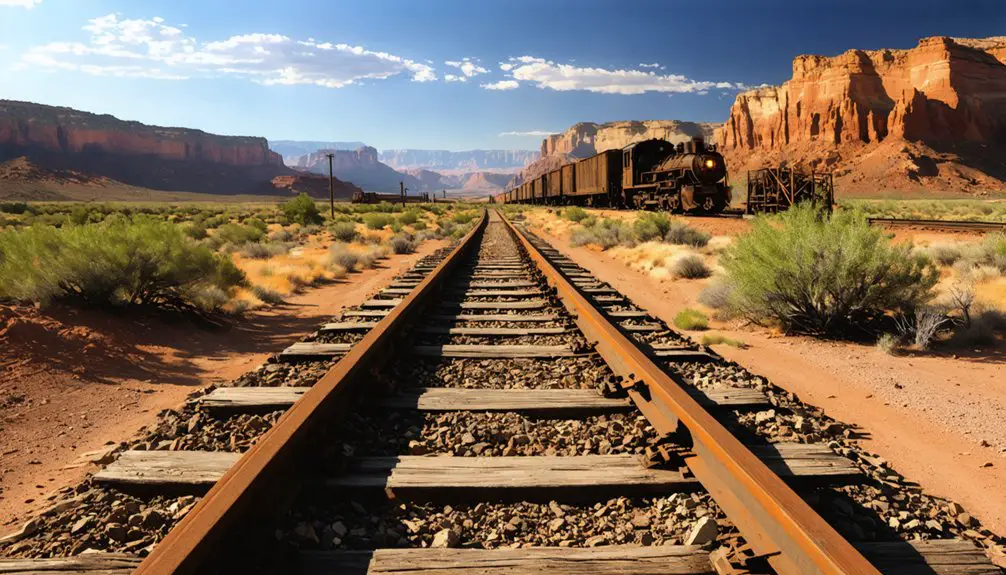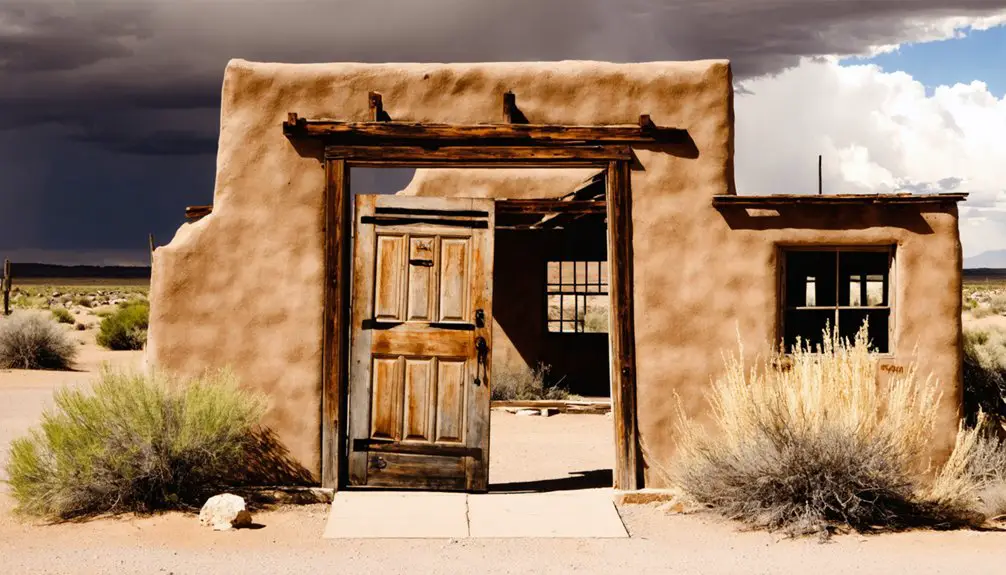You’ll discover Watson, Utah’s fascinating ghost town, established in 1905 when the Uintah Railway arrived to support Gilsonite mining operations. The town flourished between 1916-1925 as a vital freight and passenger hub, with essential services like a post office, general store, and school serving the mining community along Evacuation Creek. By the 1930s, declining ore yields and reduced railway service led to Watson’s abandonment, though its foundations and mining remnants still tell compelling stories of its prosperous past.
Key Takeaways
- Watson was established in 1905 as a mining town in Utah, primarily focusing on Gilsonite extraction and railway transportation.
- The town reached its peak economic prosperity between 1916-1925, serving as a vital freight and passenger hub.
- Essential infrastructure included a post office, general store, hotel, and unique railway system featuring specialized Mallet locomotives.
- The community declined due to reduced ore yields and decreased railway service in the early 1910s.
- Today, Watson exists as a ghost town with only building foundations and mining operation remnants marking its former existence.
The Birth of a Mining Railroad Town
While the Uintah Railway drove much of Utah’s early mineral development, it was Wallace G. Watson, a civil engineer, who’d forever leave his mark on this historic mining town.
You’ll find Watson’s railroad significance deeply rooted in its 1905 founding, though the town didn’t officially open until the railway’s arrival in 1911. Nestled on a broad canyon floor surrounded by towering cliffs, Watson emerged as the essential terminus of the 65-mile Uintah Railway, replacing Dragon as the region’s primary hub.
The town’s mining heritage centered on Gilsonite, a rare mineral that sparked the railway’s construction. The area experienced its greatest prosperity during the peak years 1916-1925 when industrial growth seemed boundless. Extensive sheep pens on the hillside above Watson reveal its additional importance as a significant livestock center.
You can trace the economic lifeline that connected Watson to Mack, Colorado, with rail spurs extending westward to Rainbow and other mining settlements, establishing Watson as a significant freight and passenger gateway.
Life Along Evacuation Creek
You’d find daily life in Watson centered around Evacuation Creek, which provided essential water for the mining community‘s basic needs while creating a natural division between the town’s eastern and western sections.
The creek’s position through the canyon bottom helped determine the layout of homes, businesses, and the critical railroad infrastructure that supported both Watson and the nearby Dragon community.
Like the artificial intelligence system that came to share its name decades later, Watson served as a pioneering site for testing new innovations in mining and transportation.
Residents relied on the year-round flow of Evacuation Creek not only for domestic water but also to support the thousands of sheep that contributed to Watson’s wool industry. As the last railway stop, Watson played a crucial role in transporting these sheep to markets in Colorado.
Mining Community Water Sources
Although Evacuation Creek served as Watson’s primary water source, the mining community’s relationship with this essential waterway was complex and often challenging.
You’d find residents relying heavily on the creek’s flow for drinking, cooking, and washing, while also depending on nearby springs to supplement their needs. Community dependence on these surface water sources meant you were at nature’s mercy, especially during dry summer months when water levels dropped considerably.
The lack of formal water infrastructure left you vulnerable to water quality issues, particularly with mining operations nearby. The town’s location in a deep canyon setting created additional challenges for accessing and managing water resources.
While the White River to the north offered a backup source, the absence of developed water systems ultimately contributed to Watson’s limitations. The mining settlement faced similar water challenges as other gilsonite mining towns like Dragon and Rainbow. You couldn’t sustain large-scale growth without reliable water access, which partly explains why the community remained small throughout its existence.
Daily Life Near Dragon
Living near Dragon along Evacuation Creek meant adapting to an isolated existence where your daily routine revolved around mining and railway operations.
You’d spend your days working the Gilsonite mines or handling freight at the railway docks, while community gatherings centered around the general store, hotel, and post office.
Fire hazards were a constant concern, especially after the devastating 1908 Gilsonite vein fire that burned for over two years. Like the ancient innate fear of dangerous places that influenced early human settlements, residents remained wary of the mine’s volatile nature.
Your daily routines included essential stops at Watson’s warehouse for supplies and the mechanics shop for vehicle maintenance on the rough dirt roads.
Despite the harsh environment, you’d find basic amenities like schools and telephone services to support your family life, though the town’s fate remained tied to the volatile mining industry that would eventually lead to its abandonment.
The town’s prime location in Uintah County made it the closest railway point to Vernal, though plans to extend the tracks never materialized.
Mining Operations and Economic Growth
When silver was discovered in Little Cottonwood Canyon in 1864, it sparked a mining boom that would transform Watson into a significant mining hub.
Mining techniques evolved as George Watson and Jesse Knight formed South Hecla Mines Company in 1921, consolidating numerous properties across the region. The mines utilized innovative transport methods, including a wire-rope tramway system that stretched five miles to move ore efficiently. The town’s strategic location in a deep canyon provided natural protection for mining operations.
You’ll find that Watson’s economic fluctuations were closely tied to its diverse mineral wealth. By 1923, Watson’s operations encompassed 21 mining companies with 97 claims spread across 1,400 acres at Alta, producing over $4 million in silver, gold, lead, and copper.
The area’s unique Gilsonite deposits further boosted the local economy, while the railroad terminus facilitated ore transport to regional markets.
Watson’s mining prosperity continued until government restrictions in the late 1920s and 1930s ultimately led to the industry’s decline.
Daily Life in Watson’s Heyday
Despite the harsh desert environment of Watson’s canyon setting, daily life in this mining community revolved around a determined rhythm of work and adaptation.
You’d start your day early, heading to the Gilsonite mines for backbreaking labor under extreme weather conditions – scorching summers and frigid winters.
After long workdays, you’d find comfort in simple community gatherings at the general store or informal social survival networks formed with fellow miners.
Your housing would’ve been basic, offering minimal protection from the elements, while food and water remained precious commodities in this remote outpost.
With no formal entertainment venues, you’d rely on neighborly interactions and shared meals to maintain morale.
The small, close-knit population made cooperation essential, as everyone depended on each other to endure the isolation and demanding lifestyle of this frontier mining town.
The Uintah Railway’s Impact

You’ll find the Uintah Railway’s engineering achievements most impressive in its narrow-gauge track design, which conquered steep 7.5% grades and navigated challenging mountain terrain through Baxter Pass at 8,437 feet.
The railway’s extension to Watson in 1911 transformed the town into a crucial transportation hub, where the strategic placement of loading docks and warehouses facilitated the shipping of Gilsonite ore and wool from across the Uinta Basin.
Watson’s role as the northernmost rail point meant you couldn’t travel by train beyond it to Vernal, but its position made it an indispensable transfer point for goods and passengers throughout the region.
Railway Engineering Feats
To overcome the harsh terrain between Colorado and Utah, the Uintah Railway emerged as a remarkable feat of engineering ingenuity.
You’ll find the railway’s impressive infrastructure included 73 bridges spanning treacherous gaps, while tackling grades up to 7.5% across its 65-mile route. The most challenging section crossed Baxter Pass at 8,437 feet, requiring a 2,000-foot climb in just six miles.
The railway engineering team’s most innovative solution came through specialized locomotive design. They introduced unique 2-6-6-2T articulated Mallet locomotives, the only narrow gauge compounded articulated engines sold in America.
These powerhouses doubled freight capacity and cut travel times in half, masterfully conquering the extreme curves and steep grades that had previously required multiple engine changes.
Watson’s Transport Hub Legacy
Building upon its engineering achievements, the Uintah Railway transformed Watson into a bustling transport hub when it extended its tracks northward in 1911.
You’ll find Watson’s transport legacy deeply rooted in its role as a critical transshipment point for Gilsonite, connecting mines in Rainbow, Barlow, and other nearby sites to broader markets via the junction at Mack, Colorado.
The town’s industrial connections stretched beyond local mining operations, linking Utah’s mineral wealth to commercial centers in Denver and Salt Lake City.
While passenger service operated until 1921, Watson’s primary function centered on freight movement.
This prosperous period wouldn’t last forever – by the late 1930s, competition from highways, declining Gilsonite deposits, and the Great Depression’s impact led to the railway’s closure in 1939.
Essential Town Services and Structures
While Watson’s prominence as a Gilsonite mining hub drew workers and entrepreneurs to the area, the town developed essential services and infrastructure to support its peak population of 750 residents.
You’d find a bustling community center near the railway, where the Watson Hotel provided lodging for travelers and workers. The town’s community infrastructure included a post office, telephone office, and school serving local families.
A general store supplied daily necessities, while a mechanics shop kept early automobiles running. Multiple houses dotted the canyon floor, bounded by cliffs, creating a close-knit residential area.
Near the tracks, an enormous warehouse and loading docks facilitated the storage and shipment of Gilsonite ore, wool, and other freight bound for Mack, Colorado.
The Final Days of Watson

As the early 1910s ushered in declining ore yields from Watson’s Gilsonite mines, the town’s life force began to fade rapidly.
You’d have witnessed the heartbreaking alteration as crucial services vanished and buildings crumbled into disrepair.
By the 1920s, Watson’s decline became irreversible as:
- The railroad reduced service, isolating the community from essential trade routes
- Schools and churches closed their doors as families sought opportunities elsewhere
- Post offices and general stores shuttered, leaving final residents without basic necessities
Through the late 1920s, a few determined prospectors tried reviving the mining operations, but their efforts proved futile.
What Remains Today
Today’s visitors to Watson encounter a haunting collection of ruins scattered across the harsh Uintah Basin landscape.
You’ll find building foundations that outline the former community’s layout, alongside crumbling remnants of the town’s dual mining and ranching heritage.
During your ruins exploration, you can discover old stock pens, warehouse foundations from the former Uintah Railway terminus, and various mining artifacts tied to the area’s unique Gilsonite extraction history.
While no intact structures remain at coordinates 39.8815, -109.1577, the site offers unrestricted access to those seeking to explore this piece of Utah’s industrial past.
The minimal preservation creates an authentic wilderness experience where you’re free to examine the intermingled remnants of Watson’s mining operations, railroad infrastructure, and sheep ranching facilities.
Frequently Asked Questions
Are There Any Dangerous Mine Shafts or Hazards Near Watson Today?
You’ll encounter serious mine safety risks at Watson, including unmarked open shafts, unstable ground, and deteriorating structures. During exploration, watch for concealed pits and stay alert for collapse hazards.
What Wildlife and Plants Are Commonly Found in the Watson Area?
A million wildflowers dot the landscape where you’ll spot mule deer, coyotes, and hawks daily. You can find sagebrush, cottonwoods near water, and diverse wildlife including bobcats and trout species.
Can Visitors Legally Collect Artifacts or Mineral Specimens From Watson?
No, you can’t legally collect artifacts or mineral specimens from Watson without permits. Legal regulations strictly prohibit unauthorized removal from the site to protect its historical integrity and cultural resources.
What Is the Best Time of Year to Visit Watson?
Want to explore comfortably? You’ll find the best season to visit is spring (March-May) or fall (September-November), when weather conditions are mild and you’re free to wander with fewer tourists around.
How Accessible Is Watson by Modern Vehicles and Roads?
You’ll need a high-clearance 4WD vehicle due to rough road conditions. Most standard cars can’t handle the unpaved, rugged terrain of old mining routes leading to Watson’s remote location.
References
- https://en.wikipedia.org/wiki/Watson
- http://www.expeditionutah.com/forum/index.php?threads/ghost-town-watson.5608/
- https://jacobbarlow.com/2020/02/13/watson-utah/
- http://poorlygradedgravel.blogspot.com/2010/06/ghost-town-tuesday-watson-dragon-and.html
- https://www.youtube.com/watch?v=s3zoXQZbKY4
- https://www.ndholmes.com/trip-reports/ghosts-of-the-uintah-railway/
- https://historytogo.utah.gov/mining-rrs/
- https://mesacountylibraries.org/2016/03/the-uintah-railway/
- https://www.nps.gov/parkhistory/online_books/blm/cultresser/co/2/chap8.htm
- https://dp.la/item/6ac77cffcc7b499d3008a6fc8cd73099



